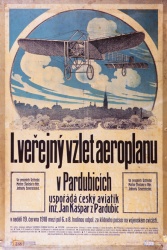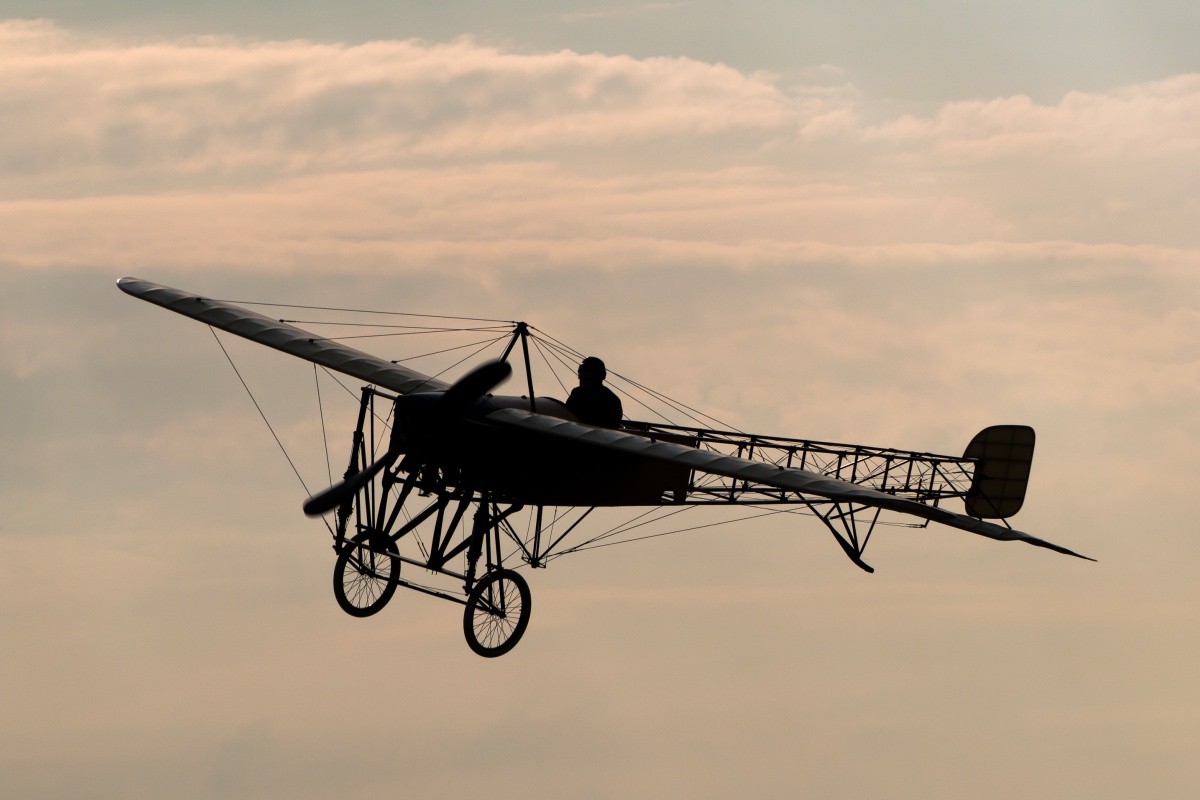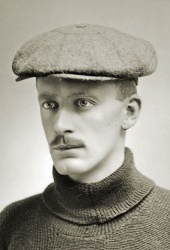Ing. Jan Kašpar is probably the most famous Czech pilot, designer and pioneer of aviation. However, he became most known to the general public with his long-distance flight from Pardubice to Prague’s Chuchle. The slightly life-size statue of this Czech pilot stands today on Míru Avenue in Pardubice and his bust is located in the departure hall of Václav Havel Airport in Prague.
He was born on May 20, 1883 in the Veselka Hotel in Pardubice to the wealthy citizen František Kašpar. From September 1888 he started attending a boys’ primary school in Nové Město. Two years later, he took part in a boys’ cycling race, where he took a beautiful second place. In July 1893 he enrolled at the Real Higher School, where in June 1901 he successfully passed the school-leaving examination. In October of the same year he enrolled at the C. and K. Czech Technical University in Prague. However, from October 1906 he began full-time military service in Pulja and thus obtained the title of mechanical engineer after passing the II. state exams until February 28, 1907. Then he went to study at the 1st German Vocational School of Automotive in Mainz, where, however, he completed only one semester. In March 1908, he began working for Basse & Selve in Altena, Westphalia, on the construction of aluminum components for airships. During this time he also became very intensely interested in aviation, where he completed his first flight, then still in the balloon.
The first attempts at takeoff and public production
The following year he returned to Bohemia and started working for the Laurin & Klement company in Mladá Boleslav. In July of the same year, however, he left the car factory and after returning to his native Pardubice, together with his cousin Ing. Evžen Čihák began to devote himself fully to the construction of aircraft. He first began building a monoplane modeled on the Antoinette, and although he learned of the success of his French colleague Louis Blériot during construction, he completed the construction of his machine. However, he never managed to take off fully with him, so after several unsuccessful attempts, he bought a Blériot XI aircraft (serial number 76) for 18,000 francs. At the request of Father František Kašpar, on January 26, 1910, the city council approved the construction of a temporary shed (hangar) for his son Jan’s plane. Here, at the beginning of April of the same year, together with his cousin Evžen Čihák, he started assembling the machine itself, replacing the original power unit with an engine of its own design (later replaced by the Anzani type) and its careful testing.
 On Wednesday, April 13, the first attempts to take off in the length of several hundred meters took place, which unfortunately ended in a damaged propeller. Despite this failure, the national politics wrote about him on the same day:
On Wednesday, April 13, the first attempts to take off in the length of several hundred meters took place, which unfortunately ended in a damaged propeller. Despite this failure, the national politics wrote about him on the same day:
“The new Czech aviator engineer Kašpar from Pardubice bought Blériot and intends to train with him on the Pardubice race track.”
Three days later, on Saturday 16 April, he managed to make his first successful flight over an entire military training ground about 2 kilometers long. On the same day, however, two months later, he managed to pass a pilot test in front of the commission. Jan Kašpar organized his first public aviation production on Sunday, June 19, between half past five and eight o’clock in the evening. During these two and a half hours, despite the unfavorable wind, he performed three successful flights over a military training ground where he was watched by more than 22,000 paying spectators. This was followed by a series of several more public takeoffs, which ended with an emergency landing in July 1912.
At the second performance in Pardubice on July 18, 1910, he managed to stay in the air for 28 minutes and during them climb to a height of 150 m, which was his new personal record. In Olomouc, although the local Germans were initially strongly opposed to the event, in the end it was successfully implemented. The first production in Prague was an unprecedented success and therefore another performance took place on October 2 of the same year, and this time Kašpar performed together with Ing. Josef Sablatnig from Klagenfurt. It is also interesting that during the event in Čáslav in 1911, probably his only color photograph was taken. In his native Pardubice, during his third performance, he managed to set an unofficial altitude record at which he reached 785 m. In December 1911, Kašpar performed in Mělník and at the racetrack in Prague’s Chuchle together with his cousin Evžen Čihák.
Long distance flights
The year 1911 was for Ing. Kašpara extremely fertile. He started the new aviation season on March 12 with several training flights over Pardubice and on April 23 he made his first flight over the wider surroundings of this city. In the meantime, he managed to complete his new monoplane of his own design by installing an Aerodaimler AD 65 engine with an output of 48 kW. At the end of the month, he made an orientation flight from Pardubice to Chrudim, which lasted less than 25 minutes. During this flight, he also managed another championship, which was the first flight with a passenger. The passenger was none other than his cousin Evžen Čihák. The memorable long-distance flight Pardubice – Velká Chuchle lasting 92 minutes took place on Saturday 13 May, during which the aviator managed to cover a distance of 121 kilometers. Two years later, the aircraft with which he managed to cover this distance was donated to the Technical Museum of the Kingdom of the Czech Republic (today’s NTM Prague) and you can still see it exhibited here. Jan Kašpar made many smaller flights, mainly returns from public performances (eg from Čáslav, Vysoké Mýto, Kolín or Dvůr Králové).
On Thursday, June 22, he unsuccessfully tried to pass a pilot test in Vienna according to international rules, during which he damaged the plane during landing. After a public performance in Kolín, held on August 13, his engine broke down during the return trip and the aviator was forced to make an emergency landing at Přelouč. Two months later, on the same day, Kašpar tried to fly from Pardubice to Jičín, but unfortunately got lost and crashed during the trip back to his native Pardubice. He was injured and the machine was severely damaged after the collision. However, as early as November 20, the healed pilot began rehearsing his repaired aircraft, and on December 3, he continued his tour with a public production in Mělník. On Sunday, December 6, he made his last long-haul flight, this time on the route Mělník – Velká Chuchle. He managed this distance in 42 minutes, and Jaroslav Kalva, the editor of Národní politika, became his somewhat indomitable passenger. He later commented on the flight:
“Since the weather was not exactly favorable, I wanted to fly alone, but editor Kalva resolutely sat on the plane and did not want to get out of it. They say I won’t make fun of him.”
Although Kašpar did not have a place to sit at first, he managed to solve this sudden situation by modifying and installing the purchased wicker chair in the fuselage.
World War I and civilian life
As early as July 1910, the Pardubice City Council established the Aviation Department, which later became part of the Aviation Team, established on September 14, 1910. This team, founded on April 26, 1911, aimed to support Pardubice Aviation, create conditions for professional training of pilots, acquire airports and build hangars. After the team managed to build hangars and the number of aircraft owned by Kašpar was added, it opened an aviation school. The Čiháková brothers, the controversial Vincenc Barthell, who, according to surviving sources, was more of a speaker and a con man than an aviator, worked with him at the Pardubice airport. Furthermore, the manufacturer and inventor Ludvík Očenášek, who at that time had the largest aircraft in Pardubice. After the end of public productions, Ing. At the beginning of February 1913, Kašpar still managed to complete the installation of a new engine in his monoplane, but it never flew. On Saturday, May 3, 1913, he was struck by a sad event, his father František Kašpar, the owner of the famous Veselka Hotel, died and he himself had to devote more time to family property. At the General Meeting of the Aviation Cooperative in Pardubice, on May 11 of the following year, he was elected administrator of the cooperative’s hangar.
He devoted himself to this activity and until Sunday, August 15, 1915, when he was transferred again, this time to the 98th Regiment in Vysoké Mýto. During the war, Kašpar also enlisted in the Air Corps, but his application was not accepted by the military administration. The reason was probably, among other things, that he failed the already mentioned international pilot test in Vienna. For the new year 1917, Kašpar was assigned as the head of the workshop of the motoring school of the Austrian Army field tracks in Korneuburg, and on Wednesday, August 1 of the same year, he was promoted to lieutenant. After the founding of Czechoslovakia, he enlisted in the military air force, but due to the fact that he did not fly for many years and completed a total of twenty-five flight hours, he never got into the cockpit again. He served here until February 24, 1919, when he was released from the congregation on permanent leave. In June of the same year, he also became a member of the Czechoslovak Aviation Club. After finishing his career in aviation, he decided to devote more time to the management of family property and also decided to do business. Therefore, on Wednesday, August 18, 1920, together with three other partners, Václav Polák, Ing. Jan Kaspar et al. s.r.o. dealing with wood processing (steam saw).
However, he was not very successful in this regard and after a failed trade on the stock exchange he became a debtor. To get rid of his financial obligations, he got hired as an official of the Ministry of Public Works and tried his best to sell the sawmill. He last looked among the planes on July 18, 1923, when he flew as a passenger of an Aero A-10 airliner to the international air show in Gothenburg, Sweden. He then retired and lived a solitary life with his sister. It is said that at that time he also suffered from a mental illness and solved the problems with alcohol, as some witnesses recalled. Four years later, on March 2, 1927, Ing. Jan Kašpar under strange circumstances. The most commonly mentioned version is when a sick and broken aviator tries to hang himself on his own scarf soaked in gasoline in the sawmill’s office. In the morning, he is recovered by unconscious employees, and although he is quickly taken to hospital, he dies a few days later of pneumonia caused by a cold and petrol fumes at the age of only 43 years.
source:
http://cs.wikipedia.org/wiki/Jan_Kašpar
http://aviatickapout.cz/cs/historie/jan-kaspar/
https://www.extrastory.cz/zahadna-smrt-jana-kaspara-chtel-si-vzit-zivot-kvuli-dluhum-nebo-moc-cichal
https://www.dotyk.cz/publicistika/sledovaly-ho-tisice-v-nedeli-19-cervna-1910-jan-kaspar-prvne-verejne-vzletl-20180619.html
https://www.lidovky.cz/lide/pohnute-osudy-jan-kaspar-vztetl-jako-prvni-cech-smrt-nasel-vlastni-rukou.A160717_100950_lide_ELE


